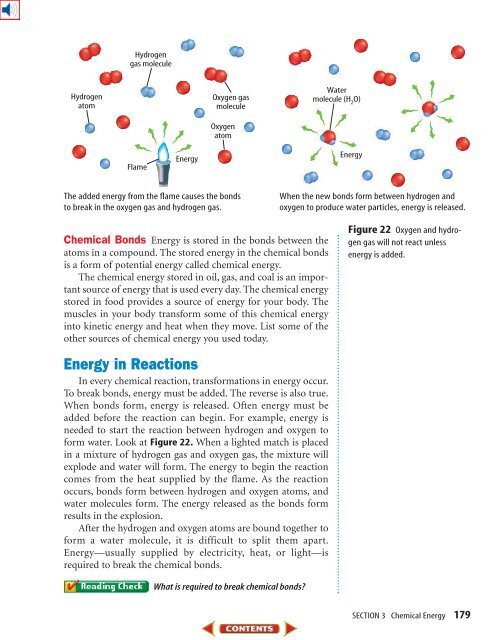chap06 - Learning Services Home
chap06 - Learning Services Home
chap06 - Learning Services Home
- No tags were found...
You also want an ePaper? Increase the reach of your titles
YUMPU automatically turns print PDFs into web optimized ePapers that Google loves.
Hydrogengas moleculeHydrogenatomOxygen gasmoleculeOxygenatomWatermolecule (H 2O)FlameEnergyEnergyThe added energy from the flame causes the bondsto break in the oxygen gas and hydrogen gas.When the new bonds form between hydrogen andoxygen to produce water particles, energy is released.Chemical Bonds Energy is stored in the bonds between theatoms in a compound. The stored energy in the chemical bondsis a form of potential energy called chemical energy.The chemical energy stored in oil, gas, and coal is an importantsource of energy that is used every day. The chemical energystored in food provides a source of energy for your body. Themuscles in your body transform some of this chemical energyinto kinetic energy and heat when they move. List some of theother sources of chemical energy you used today.Figure 22 Oxygen and hydrogengas will not react unlessenergy is added.Energy in ReactionsIn every chemical reaction, transformations in energy occur.To break bonds, energy must be added. The reverse is also true.When bonds form, energy is released. Often energy must beadded before the reaction can begin. For example, energy isneeded to start the reaction between hydrogen and oxygen toform water. Look at Figure 22. When a lighted match is placedin a mixture of hydrogen gas and oxygen gas, the mixture willexplode and water will form. The energy to begin the reactioncomes from the heat supplied by the flame. As the reactionoccurs, bonds form between hydrogen and oxygen atoms, andwater molecules form. The energy released as the bonds formresults in the explosion.After the hydrogen and oxygen atoms are bound together toform a water molecule, it is difficult to split them apart.Energy—usually supplied by electricity, heat, or light—isrequired to break the chemical bonds.What is required to break chemical bonds?SECTION 3 Chemical Energy 179














